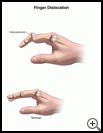
Finger Dislocation: Teen Version
________________________________________________________________________
KEY POINTS
- A finger dislocation means that the bones in your finger have moved out of place so that the joint no longer works properly.
- To treat dislocation, your provider will gently pull apart the injured parts and reposition them in the proper place. If your finger cannot be properly repositioned, you may need surgery. Your finger may be placed in a splint or taped to the finger next to it for several weeks.
________________________________________________________________________
What is a finger dislocation?
A finger dislocation means that the bones in your finger have moved out of place so that the joint no longer works properly. The dislocation can put pressure on the nerves and blood vessels in your finger and can damage them. When your finger is dislocated, you may also have broken bones.
Your finger may have less flexibility and strength for many weeks. Sometimes the joint swelling may take weeks or months to go away, and in some cases may be permanent.
What is the cause?
A dislocated finger is usually caused by a fall, a hit to the tip of your finger, or getting your finger caught in something. It may also be caused by weak or loose ligaments that you were born with. Ligaments are strong bands of tissue that connect one bone to another.
What are the symptoms?
Symptoms may include:
- Swelling
- Pain
- Bruising
- A change in the shape of the finger that makes it look crooked or out of place
- Being unable to bend or straighten your finger
How is it diagnosed?
Your healthcare provider will ask about your symptoms and medical history and examine you. You will have X-rays.
How is it treated?
Your healthcare provider will put the bones back in the correct position. You may need to have a local anesthetic to keep you from feeling pain when this is done. Your provider will gently pull apart the injured parts and reposition them in the proper place. If your finger cannot be properly repositioned, you may need surgery.
Your finger may be placed in a splint or taped to the finger next to it (buddy taped) for several weeks. This prevents your joint from moving while it heals. When the splint is removed, your healthcare provider may recommend stretching and strengthening exercises to help you heal.
How can I take care of myself?
Follow the full course of treatment prescribed by your healthcare provider. In addition:
- Put an ice pack, gel pack, or package of frozen vegetables wrapped in a cloth on the injured area every 3 to 4 hours for up to 20 minutes at a time.
- Raise your hand on a pillow so that it is above the level of your heart when you sit or lie down.
- Take nonprescription pain medicine, such as acetaminophen, ibuprofen, or naproxen. Read the label and take as directed. Unless recommended by your healthcare provider, you should not take these medicines for more than 10 days.
- Nonsteroidal anti-inflammatory medicines (NSAIDs), such as ibuprofen, naproxen, and aspirin, may cause stomach bleeding and other problems. These risks increase with age.
- Acetaminophen may cause liver damage or other problems. Unless recommended by your provider, don't take more than 3000 milligrams (mg) in 24 hours. To make sure you don’t take too much, check other medicines you take to see if they also contain acetaminophen. Ask your provider if you need to avoid drinking alcohol while taking this medicine.
- Do the exercises recommended by your healthcare provider.
Ask your provider:
- How long it will take to recover
- If there are activities you should avoid and when you can return to your normal activities
- How to take care of yourself at home
- What symptoms or problems you should watch for and what to do if you have them
Make sure you know when you should come back for a checkup. Keep all appointments for provider visits or tests.
Last modified: 2016-09-01
Last reviewed: 2016-08-31

